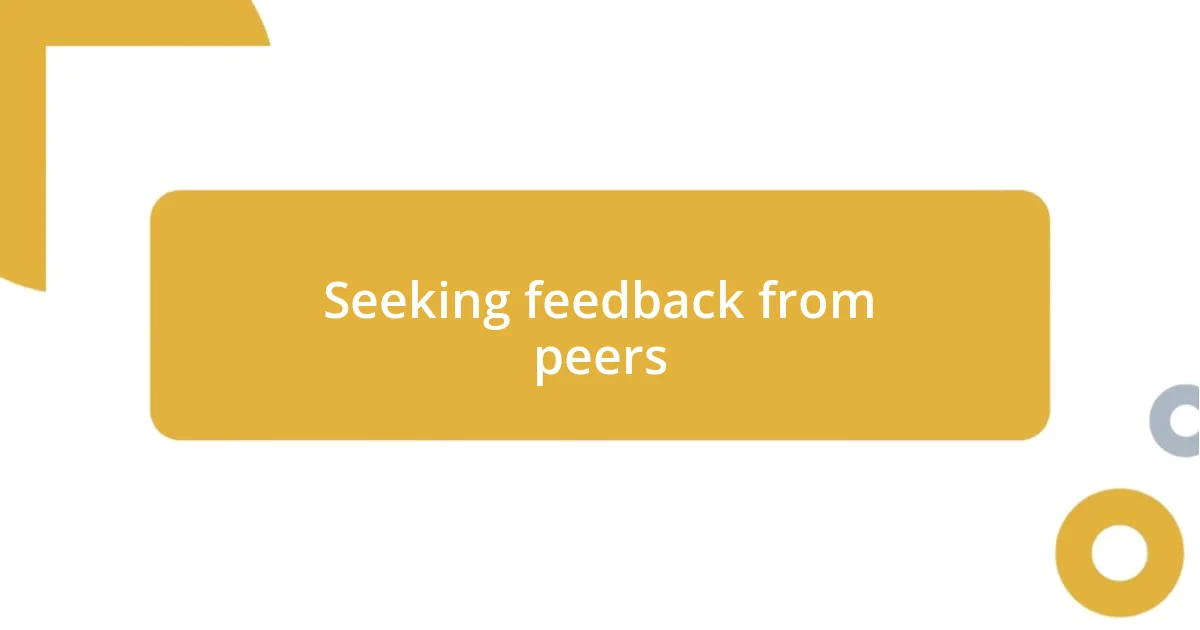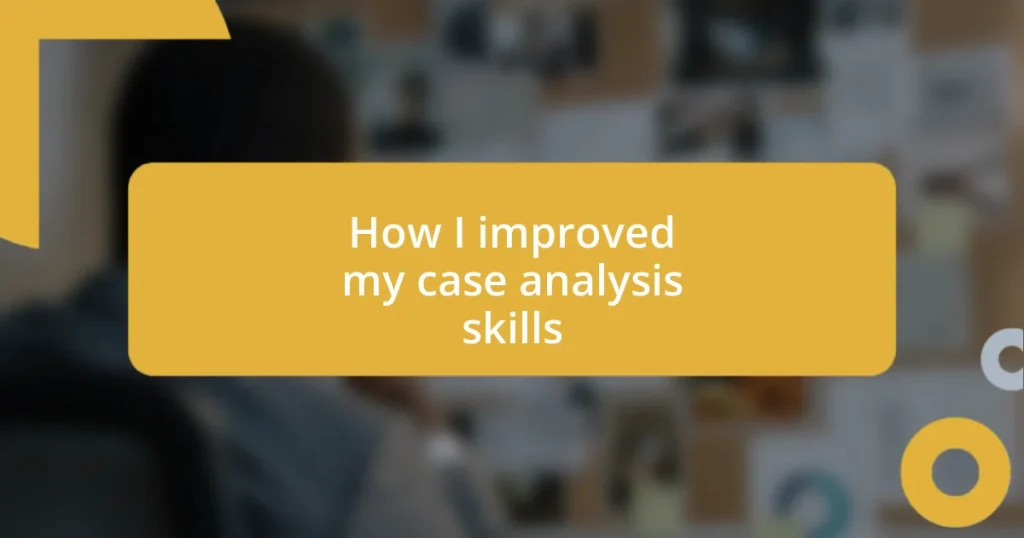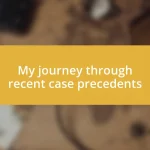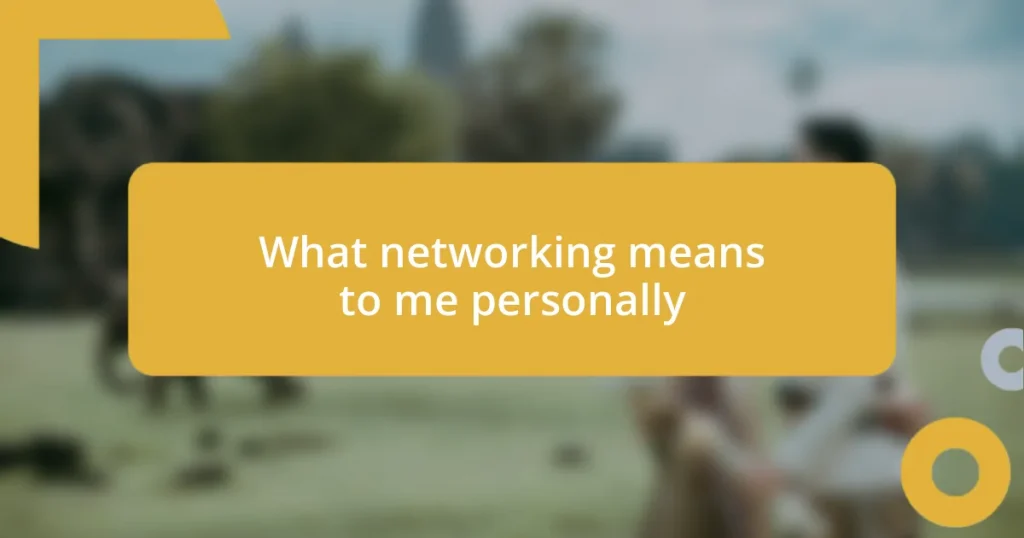Key takeaways:
- Understanding and applying analytical frameworks like SWOT and PESTEL can simplify complex case analysis and uncover new insights.
- Engaging in open dialogue and seeking peer feedback fosters richer analyses and enhances critical thinking skills.
- Tracking progress through journaling and self-assessment helps identify strengths and areas for improvement in case analysis skills.

Understanding case analysis fundamentals
Understanding the fundamentals of case analysis is essential for bringing clarity to complex problems. I remember grappling with a particularly challenging case early in my studies, unsure of how to untangle the myriad of issues presented. It’s in moments like these that recognizing the underlying structure of a case can transform confusion into insight.
At its core, case analysis requires a systematic approach to breaking down information. I learned to look for patterns and themes, which made the process feel less overwhelming. Have you ever paused to consider how revealing the story behind the data can be? When I began to prioritize understanding the motivations and context of the characters involved, my conclusions became much more robust.
Additionally, the integration of both qualitative and quantitative data is vital in this process. I found that blending hard numbers with human emotions opened up a new dimension of understanding. Just think about it—how often do data points alone tell the complete story? By grounding my analysis in both facts and feelings, I not only improved my skills but also developed a deeper empathy for those affected by the issues at hand.

Identifying key analytical frameworks
Identifying key analytical frameworks has been pivotal in enhancing my case analysis skills. When I first encountered frameworks like SWOT analysis and Porter’s Five Forces, it was like discovering a map in a vast, uncharted territory. Each framework served as a lens, allowing me to dissect cases more effectively. It’s fascinating how applying these structured approaches illuminated different aspects of the problems I was trying to solve.
- SWOT Analysis: This helps identify strengths, weaknesses, opportunities, and threats, making it easier to understand a case’s internal and external factors.
- Porter’s Five Forces: Utilizing this framework clarified the competitive dynamics at play, which often transformed my view of the market landscape.
- PESTEL Analysis: Focusing on political, economic, social, technological, environmental, and legal factors broadened my perspective, reminding me of the complexities surrounding issues.
- Value Chain Analysis: This highlighted the operational steps that contribute to a product’s value, which surprised me in revealing hidden inefficiencies in many cases.
As I explored these frameworks, I started to feel empowered. Each time I applied one, it was like finding a new tool in my toolkit. I remember during a group project, we were stuck on how to tackle a particularly intricate case. I suggested we map it using the PESTEL framework, and it was enlightening! Suddenly, factors that seemed obscure became clear and actionable. That day reinforced my belief that having the right analytical frameworks can make all the difference in navigating complexity.

Developing critical thinking strategies
Developing critical thinking strategies has been a game-changer in my approach to case analysis. Initially, I often found myself overwhelmed by the data and narratives presented. However, I quickly realized that by asking the right questions, I could guide my thought process. Take a moment and think about how probing deeper into the “why” behind a case can illuminate hidden truths. For example, when analyzing a recent case study on consumer behavior, I asked myself why certain trends emerged rather than just noting what those trends were. That shift in perspective made all the difference in my understanding.
Another tactic I found invaluable was fostering an environment of open dialogue, whether within study groups or professional settings. Engaging in discussions where differing viewpoints are welcomed led to a richer analysis of the case at hand. Have you ever had an “aha” moment simply by hearing someone else’s take? I can recall a memorable group session when someone challenged a conclusion I had reached; that healthy debate not only clarified my position but also introduced me to new approaches I hadn’t considered.
Lastly, reflecting on my own thinking process has been essential. By keeping a journal of my case analyses, I began to notice patterns in my reasoning—both strengths and weaknesses. This journaling practice helped me critically evaluate my approaches and become more self-aware. It’s like having a personal conversation with myself about my thought processes. Isn’t it fascinating how self-reflection can propel growth? I remember the first time I reviewed my notes and saw how much I had changed in my analytical skills. It was a rewarding realization that encouraged me to keep pushing my limits.
| Critical Thinking Strategy | Description |
|---|---|
| Asking Deeper Questions | Encourages exploration of underlying reasons, enhancing understanding of complex issues. |
| Open Dialogue and Discussions | Facilitates diverse perspectives, often leading to richer insights and clearer analyses. |
| Self-Reflection Journaling | Promotes critical evaluation of one’s own thought processes, fostering growth and improvement. |

Practicing real-world case studies
Practicing real-world case studies has been an eye-opening experience for me. One memorable instance was when I tackled a case about a failing retail chain. I immersed myself in the company’s history, customer feedback, and competitive positioning. The more I dug, the more I felt like a detective piecing together clues to solve a puzzle. Isn’t it wild how real-world context can breathe life into theoretical frameworks?
I also found that presenting my case analysis ideas to peers was invaluable. During one session, I shared my findings on a tech startup’s growth strategies. The moment I noticed my classmates’ reactions—it was a mix of surprise and intrigue—I realized how engaging with others could refine my analysis. Have you ever felt a rush when someone else gets excited about your work? That transformative moment not only boosted my confidence but motivated me to dive deeper into my research.
In one of my recent practice sessions, I simulated a presentation as if I were pitching my analysis to potential investors. Standing in front of my mirror, I felt the energy build as I spoke about the market dynamics and financial projections. The adrenaline rush was palpable, reminding me of how crucial articulation is in case studies. Have you ever rehearsed your thoughts aloud, only to discover new angles you hadn’t considered? That exercise taught me that real-world practice isn’t just about the content but also about conveying it effectively.

Seeking feedback from peers
Engaging peers for feedback has been a pivotal step in refining my case analysis skills. I remember presenting a draft of my analysis on a marketing strategy to my study group. Their insights weren’t just helpful; they provided a fresh lens through which I could view my work. Have you ever had your assumptions challenged in a way that completely changed your perspective? That experience motivated me to solicit feedback more actively, realizing how collective thought can elevate individual understanding.
I often find that feedback sessions transform into lively discussions that spark new ideas. For instance, during a recent critique, a fellow student pointed out an overlooked detail that turned out to be the linchpin of my case analysis. At that moment, I felt a surge of excitement—how could I have missed something so critical? These exchanges not only clarify my thoughts but also create a community where everyone’s ideas are valued, enhancing the overall learning experience. Wouldn’t it be amazing if we could harness the power of constructive criticism in every aspect of our work?
It’s fascinating how seeking feedback has shifted my approach. What initially felt intimidating has become an opportunity for growth. Now, rather than fearing critique, I embrace it, viewing each piece of feedback as a chance to enhance my analytical skills. I specifically recall a time when I was hesitant to share an incomplete analysis. Once I did, the input I received not only improved my work but also instilled a sense of camaraderie with my peers. Doesn’t collaboration truly enrich the learning process? The more I invest in this exchange of ideas, the more confident and capable I feel in my analysis journey.

Measuring your progress over time
Tracking my progress in case analysis has been a revelation. I often set specific goals for myself, such as mastering a particular analytical framework or improving my presentation skills. Reflecting on these milestones not only lets me celebrate my achievements but also highlights areas where I still have room to grow. Have you ever taken the time to compare where you started to where you are now? It’s a confidence booster that truly motivates me to keep pushing forward.
One method I’ve implemented is maintaining a journal specifically for my analyses. In my entries, I document each case study’s challenges and breakthroughs. Revisiting these records allows me to see patterns in my thinking and identify recurring mistakes. It’s so enlightening! I remember a time when I couldn’t quite grasp a concept in financial modeling, but after several entries, I noticed a shift in my comprehension. Don’t you think it’s fascinating how documenting your growth can illuminate your learning journey so vividly?
Another impactful strategy is periodic self-assessment. After every major analysis, I sit down with a rubric I created that focuses on key skills, like critical thinking and clarity of presentation. I evaluate my performance honestly, and that process sometimes feels a bit uncomfortable, but it’s necessary. I can still recall how disheartening it felt when I first scored low on an assessment versus my expectations. However, instead of letting it defeat me, it fueled my determination to improve. How do you react when you face setbacks in your learning? For me, it’s about using those moments as launching pads for greater skill development.

Applying skills in professional settings
In my professional journey, applying case analysis skills has been a game-changer. I vividly remember my first real client presentation where I had to showcase a market entry strategy. The pressure was on, and I felt a whirlwind of emotions, from excitement to sheer anxiety. When I presented my analysis, I could hear the silence as the stakeholders processed the data. That moment taught me just how crucial it is to communicate insights clearly and confidently. Have you ever faced a similar scenario where your skills were put to the test, and you had to rise to the occasion?
During my internship, I realized that collaboration often enhances case analysis significantly. While working on a project with my team, we were tasked with revamping a failing product. I took the lead in gathering data, but it was my colleagues who challenged my assumptions and encouraged me to explore different market segments. I remember feeling a blend of frustration and thrill as we debated ideas, but ultimately, those discussions refined our approach and led us to a successful campaign. Isn’t it amazing how diverse perspectives can elevate a project to new heights?
In a recent analysis I conducted for a client, I leveraged my skills not just to diagnose problems but also to implement strategic solutions. In preparing my recommendations, I made a conscious effort to connect my findings with real-world applications. I found myself making diagrams and flowcharts that visually represented the data. It was satisfying to see the client’s engagement increase as I explained my reasoning. Have you felt that sense of fulfillment when your hard work resonates with others? Every time I apply my analytical skills in a professional context, I’m reminded of the profound impact clear analysis and thoughtful presentation can have on decision-making.















